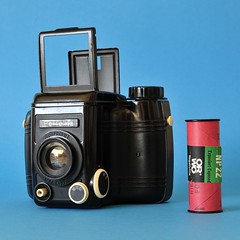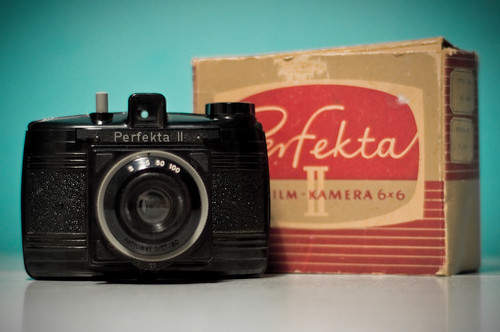Difference between revisions of "Perfekta (Bakelite)"
(switched out less informative image and added minor data) |
|||
| Line 1: | Line 1: | ||
| + | __NOTOC__ | ||
''There is also the [[Perfekta (TLR)|Perfekta folding TLR camera]]'' | ''There is also the [[Perfekta (TLR)|Perfekta folding TLR camera]]'' | ||
| + | |||
| + | The [[Bakelite]] Perfekta was a 120 rollfilm camera produced by [[VEB Rheinmetall]] in East Germany. Two models can be distinguished. | ||
<div class="floatright plainlinks" style="margin:0px 0px 0px 15px"> | <div class="floatright plainlinks" style="margin:0px 0px 0px 15px"> | ||
| Line 33: | Line 36: | ||
|} | |} | ||
</div> | </div> | ||
| − | + | ==Perfekta== | |
The '''Perfekta''' is a [[Bakelite]] 6x6 [[120 film]] fixed-focus box camera made by [[VEB Rheinmetall]] in Sömmerda, Thuringia, East Germany, c.1954.<ref name =McK>{{McKeown12}} p820.</ref> The body was made in black Bakelite, with cream-coloured controls. | The '''Perfekta''' is a [[Bakelite]] 6x6 [[120 film]] fixed-focus box camera made by [[VEB Rheinmetall]] in Sömmerda, Thuringia, East Germany, c.1954.<ref name =McK>{{McKeown12}} p820.</ref> The body was made in black Bakelite, with cream-coloured controls. | ||
| − | The original model of the Perfekta has a flip-up frame finder. The lens is an 80 mm f/7.7 achromat | + | The original model of the Perfekta has a flip-up frame finder. The lens is an 80 mm f/7.7 [[Achromatic lens |achromat lens]] There is an aperture control knob below the lens, giving f/7.7, f/11 and f/16.<ref>Two variants of the wheel have been observed. With and without little arrows indicating the correct position.</ref> A second knob on the side of the boxy lens housing selects between 'B' and 'I/M' shutter.<ref>The <b>M</b>[oment] label was used for the German market, while the <b>I</b>[nstant] label was used for the non-German-language export market</ref> The shutter-release is a button below the lens, opposite the aperture knob. The back simply snaps on. A red frame counter window, placed in the centre of the back, can be closed by turning a small plastic knob. The manufacturer's name is en relief on the back. The shutter speed selector also carries a number '1' inside a triangle,<ref>The production quality was classified through the use of numbers in triangles. A number '1' inside a triangle signalled first quality production (suitable for export). A number '2' in an upside down triangle indicated second choice, technically fully functional but with cosmetic blemishes, while an upside down triangle without any number signally defective product.</ref>and the production number: 37/286/0000. |
| − | The Perfekta is a good example of the persistence of the streamline moderne style in the 1950s | + | The design of the Perfekta is very much like the [[Druopta Efekta]], except for the placement of the shutter control and release. The Perfekta is a good example of the persistence of the streamline moderne style in the 1950s |
{{Br}} | {{Br}} | ||
| Line 74: | Line 77: | ||
</div> | </div> | ||
| + | ==Perfekta II== | ||
The more rounded '''Perfekta II''' (also c.1954<ref name=McK></ref>) is more compact, with a lens housing that collapses into the body. It has an optical finder in place of the frame finder. The lens is the same as in the original model. The aperture is set with a wheel under the lens (and is presumably a set of three circular apertures in the wheel, not an adjustable iris). The shutter now has timed speeds, 1/25 - 1/100 second plus 'B', set with a knurled (plastic) rim around the shutter housing. The shutter-release is now on the top of the body. | The more rounded '''Perfekta II''' (also c.1954<ref name=McK></ref>) is more compact, with a lens housing that collapses into the body. It has an optical finder in place of the frame finder. The lens is the same as in the original model. The aperture is set with a wheel under the lens (and is presumably a set of three circular apertures in the wheel, not an adjustable iris). The shutter now has timed speeds, 1/25 - 1/100 second plus 'B', set with a knurled (plastic) rim around the shutter housing. The shutter-release is now on the top of the body. | ||
The Perfekta II occurs with the name in upright lettering and with it in script (as in the picture at far right). The camera was also sold by [[Sears]] as the '''Tower 66P'''. | The Perfekta II occurs with the name in upright lettering and with it in script (as in the picture at far right). The camera was also sold by [[Sears]] as the '''Tower 66P'''. | ||
Revision as of 12:10, 9 June 2011
There is also the Perfekta folding TLR camera
The Bakelite Perfekta was a 120 rollfilm camera produced by VEB Rheinmetall in East Germany. Two models can be distinguished.
|
| ||||
|
Perfekta
The Perfekta is a Bakelite 6x6 120 film fixed-focus box camera made by VEB Rheinmetall in Sömmerda, Thuringia, East Germany, c.1954.[1] The body was made in black Bakelite, with cream-coloured controls.
The original model of the Perfekta has a flip-up frame finder. The lens is an 80 mm f/7.7 achromat lens There is an aperture control knob below the lens, giving f/7.7, f/11 and f/16.[2] A second knob on the side of the boxy lens housing selects between 'B' and 'I/M' shutter.[3] The shutter-release is a button below the lens, opposite the aperture knob. The back simply snaps on. A red frame counter window, placed in the centre of the back, can be closed by turning a small plastic knob. The manufacturer's name is en relief on the back. The shutter speed selector also carries a number '1' inside a triangle,[4]and the production number: 37/286/0000.
The design of the Perfekta is very much like the Druopta Efekta, except for the placement of the shutter control and release. The Perfekta is a good example of the persistence of the streamline moderne style in the 1950s
|
| ||||
|
Perfekta II
The more rounded Perfekta II (also c.1954[1]) is more compact, with a lens housing that collapses into the body. It has an optical finder in place of the frame finder. The lens is the same as in the original model. The aperture is set with a wheel under the lens (and is presumably a set of three circular apertures in the wheel, not an adjustable iris). The shutter now has timed speeds, 1/25 - 1/100 second plus 'B', set with a knurled (plastic) rim around the shutter housing. The shutter-release is now on the top of the body. The Perfekta II occurs with the name in upright lettering and with it in script (as in the picture at far right). The camera was also sold by Sears as the Tower 66P.
The Modell P66 of c.1955 is very similar. It is marked 'Export model' on the back; the example pictured in McKeown has a cold shoe[1], so is presumably synchronised for flash.
Notes
- ↑ 1.0 1.1 1.2 McKeown, James M. and Joan C. McKeown's Price Guide to Antique and Classic Cameras, 12th Edition, 2005-2006. USA, Centennial Photo Service, 2004. ISBN 0-931838-40-1 (hardcover). ISBN 0-931838-41-X (softcover). p820.
- ↑ Two variants of the wheel have been observed. With and without little arrows indicating the correct position.
- ↑ The M[oment] label was used for the German market, while the I[nstant] label was used for the non-German-language export market
- ↑ The production quality was classified through the use of numbers in triangles. A number '1' inside a triangle signalled first quality production (suitable for export). A number '2' in an upside down triangle indicated second choice, technically fully functional but with cosmetic blemishes, while an upside down triangle without any number signally defective product.
Links
- Perfekta 1 and P66 on Camera Collectie Bakeliet (in Dutch)
- Perfekta on Ken Lyndrup's site
- This Perfekta II set in Krassimire Oumarsky's Flickr photostream shows that the Perfekta II was capable of rather good pictures.





